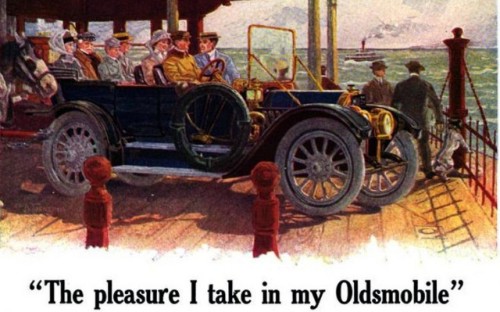Walkabout: Trains, Automobiles, and Undying Love, Part 1
Read Part 2 of this story. Dwight W. Pardee was born in New Jersey in 1852. He was educated in public schools, and attended the Wilbraham Academy in Wilbraham, Massachusetts. His first job was at the Fourth National Bank in New York City, and then he entered the railroad business. Cornelius Vanderbilt’s many railroad holdings…


Read Part 2 of this story.
Dwight W. Pardee was born in New Jersey in 1852. He was educated in public schools, and attended the Wilbraham Academy in Wilbraham, Massachusetts. His first job was at the Fourth National Bank in New York City, and then he entered the railroad business. Cornelius Vanderbilt’s many railroad holdings became his career. In 1884, he became the Assistant Treasurer of the Lake Shore & Michigan Southern Railroad Company, and in 1889 he became Secretary of the Dunkirk, Allegheny Valley, and Pittsburgh Railroad Company.
He then landing a plum job at the business office at Grand Central Station. When the Secretary of the New York Central Railroad died, Dwight Pardee assumed his job, and successfully handled the business affairs of the largest railroad system in the country. That demanding career was easy, compared to running afoul of the law in his automobile, and the love affairs of his only two children. This is the Pardee family story.
Dwight Pardee and his wife Mary had two children, Roy and Elsa. They were two years apart, and Roy was the eldest. By the time they were young adults, the Pardees were living at 1310 Dean Street, in a George Chappell designed row house featured as a Building of the Day, last week.
The Pardees were wealthy; being an executive for the Commodore paid very well, and the family enjoyed all of the perks that came with being quite well-to-do. They, like everyone else in the St. Marks District, had servants in the household, including maids, cooks and chauffeurs. Mr. Pardee was driven to work every day, and after automobiles replaced carriages, he was driven around in a handsome open touring car.
On August 14th, 1908, around 5 pm, Dwight Pardee was riding in that touring car, rolling down Nostrand Avenue towards home, driven by his chauffeur, 23 year old James Kilmurray. As the car passed Gates Avenue, they were cut off by another car, this one driven by a Brooklyn judge, Magistrate E. Gaston Higgenbotham.
Since there is a courthouse and police station on Gates Avenue, traffic policeman August Kunath was standing on the corner when the judge cut the Pardee car off, and when he came over to investigate, the judge ordered him to arrest the chauffeur for speeding. Since the judge was well known to the officer, he immediately took James Kilmurray into custody, and hauled him off to the Gates Avenue police station.
Judge Higgenbotham had a passenger with him when he decided to be the defender of Brooklyn’s streets, and since the great man had done his job, he left it to his friend, Fred Kraft, to actually go and press charges. The judge, Mr. Kraft would inform the officers at the precinct, had to get ready for court early in the morning, and couldn’t be there, but he would be on hand to offer testimony at the appropriate time.
Kraft said that the Judge had been trailing the Pardee car ever since it came over the bridge, and observed that it was being driven at a high speed. He followed it, and finally made his move near Gates Avenue. He said that Judge Higgenbotham had to go at excessive speeds himself in order to keep track of the Pardee car. Neither men knew who the passenger was, and seemed to have ignored Pardee altogether in their efforts to capture the chauffeur.
Well, as can be imagined, Dwight Pardee was not happy. He rapidly paid young Kilmurray’s $100 bail, and promised they would be in court in the morning. The next morning, all parties showed up in front of Gates Avenue Magistrate John F. Hylan. When the complainant, Mr. Kraft, acting for Judge Higginbotham arrived, he approached the chief clerk, and there was a lot of whispering going on.
Kraft was hustled into the judge’s chambers, there were papers moved around from the clerk’s desk to the judge’s office, and more whispering between the clerk and Kraft and the judge. Everyone in the courtroom was whispering too, as this activity was unprecedented. At one point, Kraft, Pardee, the arresting officer, Patrolman Kunath, and the clerk were out in the hall conferring, and more papers were signed. At last, the judge came out of his chambers, and the case was called up.
Patrolman Kunath was the first witness. He testified that he didn’t know anything about why Higgenbotham wanted the chauffeur arrested, he just followed the order. He hadn’t seen any speeding, or other law breaking personally. Fred Kraft was called up, and he testified that he was acting for his friend, “Higgy,” who was at another court that morning, but planned to show up later to testify. Judge Hylan took two minutes to throw the case out, and Kilmurray was set free. Fifteen minutes later, Judge Higgy’s car rolled up in front of the courthouse, but he had missed the boat. It was over.
Was Higgy mad? You bet. He conferred with reporters in the lobby of the courthouse, explaining that he had sent Kraft to testify, but he had obviously been “shaken down” by a very powerful and influential Dwight Pardee, who had friends in high places. He went on to explain that he had seen the car zip by, and he took it upon himself to catch it, and have the driver charged with speeding.
He didn’t know who was in the car or who owned it, but seeing now that it was Pardee, it was obvious to Higgy that the fix was in, and that Judge Hylan, Policeman Kunath and his own friend, Fred Kraft, had been intimidated or had promises made. He would think about filing the complaint again. Who knows, he may have had a point. Judge Hylan became the Mayor of New York City from 1918 to 1925. It never hurts to have friends in high places.
Friendship is a wonderful thing, but friendship, and then marriage to the wrong person, can be bad. It can also get messy, especially when your father is a prominent and wealthy man, and the social lives of such men and their families are golden to a newspaper’s readership. So the marriage of 20 year old Roy Pardee made the headlines…for all the wrong reasons.
Roy was a restless young man with a wealthy father, and no real purpose or goal in mind for his life. But Dwight was not going to let him be a ne’er do well. Automobiles played a role in the family life, so at Dad’s urging, he decided to go into the automobile business as a salesman for Oldsmobile.
With the family connections a factor, he was chosen to run the showroom and service garage at 1386 Bedford Avenue, on Brooklyn’s Automobile Row, walking distance from his house. His first cars would include the 1907 Oldsmobile Touring sedan. Roy told the papers that his facility would be the finest of its kind, and his service station would have the latest amenities and the finest car care.
One night in June, 1909, Roy went to Manhattan to take in a Broadway show. Afterward, he went to a restaurant, and it was there he met the most beautiful girl in the world. Her name was Lillian Beasley. She was young, at 22, only two years older than Roy, petite, blonde and vivacious. He was smitten, and according to one newspaper report, asked her to marry him that night, and they went to Jersey City, found a minister, and the deed was done. According to another newspaper, the courtship was longer, and took months. The fact is they married, and then the trouble began.
Twenty days later, the marriage was over. Roy moved back home to Dean Street from their new apartment in Manhattan. Lillian filed for divorce on account of abandonment. The court documents said that she had been wooed and then deceived. The man she had married had told her that he was rich, and heir to a fortune, but in fact was living on $15 a week, his salary from Oldsmobile. He told her that he owned the dealership he worked for, and was in line to receive a large inheritance from a grandfather, and then there was his rich and powerful father.
The blowup between them happened when she went shopping for a few items in a Brooklyn department store and instead of spending about $25, she spent $200, which he couldn’t afford. When the fight broke out, Roy said that Lillian had told him about a former husband, and told him she didn’t love him, and only married him for his social standing and supposed wealth.
She denied this gold digging angle and insisted that she loved him, and that he knew all about her first marriage. Lillian told the court that Roy had wanted to buy her a dog that cost $100, and told her that he owned the fine car he was driving. She blamed his family.
When Roy went back home, his father told him that he was in a mess of his own making. Dwight Pardee also told the court that Roy had not yet come into his majority, at 21, and had nothing but his salary. Roy offered to send Lillian $5 a month support, it was all he could afford, and he did so for many months until the case came to court.
When the case did come up, a year later, Roy told the court that he had left Lillian because he had found out she was stepping out with another man that she had met only days after their wedding. He said that she had told him that she was receiving $25 a week from the settlement of her first marriage, but later confessed that that was a lie, and she had nothing.
Lillian wanted $100 a week in alimony, saying that Roy’s father could afford it, even if Roy couldn’t. The judge disagreed. He awarded the couple the divorce, but set the alimony at $5 a week, saying that alimony was based on Roy’s salary and holdings, and since he owned nothing, and had no income other than the $15 salary, that was all she was going to get. The judge also said that Roy’s father’s income was irrelevant, and had no standing in the case, as Lillian was not married to the father. Roy’s marriage was over.
All of this family drama played out in the newspapers, and because of Dwight Pardee’s wealth and position with Cornelius “Commodore” Vanderbilt, one of the richest, most powerful men in America, the story was carried by newspapers all over the country. It was very embarrassing for the Pardees, and they found themselves going to their summer home in Bay Shore as often as possible to escape the press and the unwanted attention.
James Kilmurray was no longer the family chauffeur; the position now was held by another young man named Kenneth Lee Collins. As he drove the family around Brooklyn and Manhattan, and from Bay Shore and back, Kenneth caught the eye of nineteen year old Elsa Pardee. Her brother showed a profound lack of good judgment in his love life, and unfortunately for her parents, so did Elsa. Before you can say “Downton Abbey,” Elsa eloped with the chauffeur.
As can be imagined, the papers had a field day with this story of love across the class divide. Elsa’s tale next time, as well as the continuing saga of Roy, who had failed at love once, and was ready to try marriage again. And again. The Pardee family drama continues next time.





What's Your Take? Leave a Comment